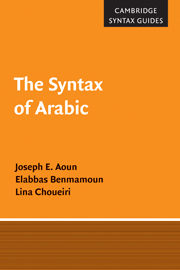Book contents
- Frontmatter
- Contents
- List of abbreviations
- 1 Issues in the syntax of Arabic
- 2 Clause structure in Arabic
- 3 The syntax of subjects
- 4 Sentential agreement
- 5 The syntax of sentential negation
- 6 Modes of wh-interrogation
- 7 Restrictive relatives
- 8 Clitic-left dislocation and focus constructions
- 9 The syntax of the Arabic left periphery
- References
- Index
7 - Restrictive relatives
Published online by Cambridge University Press: 30 March 2010
- Frontmatter
- Contents
- List of abbreviations
- 1 Issues in the syntax of Arabic
- 2 Clause structure in Arabic
- 3 The syntax of subjects
- 4 Sentential agreement
- 5 The syntax of sentential negation
- 6 Modes of wh-interrogation
- 7 Restrictive relatives
- 8 Clitic-left dislocation and focus constructions
- 9 The syntax of the Arabic left periphery
- References
- Index
Summary
Introduction
In the previous chapter, we focused on the different strategies for forming wh-interrogatives in Arabic and on their different syntactic and interpretive properties. We discussed the properties of long-distance dependencies between sentence initial wh-words and their corresponding positions within the sentence. We observed that the relationship between a wh-word and its corresponding gap within the sentence is sensitive to islands, whereas this wasn't the case for the relationship between a wh-word and its corresponding resumptive element. Furthermore, we observed that the resumptive strategy puts restrictions on the nature of the wh-antecedent, such that only wh-words that correspond to a DP can be related to a resumptive element. It is also the case that all wh-words that can be related to a resumptive element are referential, in the sense defined by Cinque (1990).
This chapter focuses on restrictive relative constructions in Arabic. In restrictive relative clause formation, it is the resumptive strategy that is the default strategy. Although gaps can be found in restrictive relatives in Arabic, their distribution is restricted in various dialects. This allows us to investigate further the properties of resumption. It will turn out that there are contexts where resumption shares characteristics of gap constructions in being sensitive to island conditions, and that referentiality does not adequately constrain the set of possible antecedents of a resumptive pronoun.
- Type
- Chapter
- Information
- The Syntax of Arabic , pp. 163 - 189Publisher: Cambridge University PressPrint publication year: 2009

